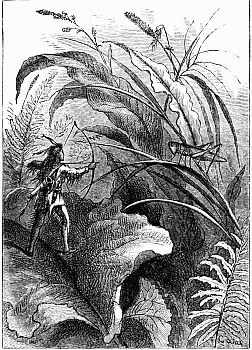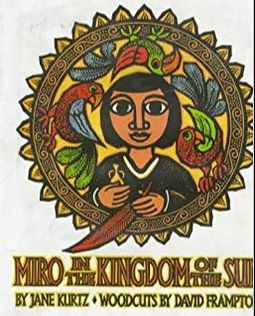|
I read this tale years and years ago and started looking for it about six years back. All I could remember was a handful of details. Then, recently, I came across it by accident. So technically I had the “Search for the Search for the Magic Lake.”
The story begins with an emperor whose son is dying. The emperor is desperate for a cure but can’t find one, until a disembodied voice tells him that his son can be cured by water from the magic lake at the end of the world. Many people search without success. Two sons of a poor farmer decide to try their luck, but like everyone else, they can’t find the magic lake. They decide to bring back some normal water – surely no one will be able to tell the difference! Shockingly, people can tell the difference and the emperor has them thrown into prison. This is a huge blow for the farmer and his family. However, they have one more child, a little girl named Súmac. In order to free her brothers, she decides to go in search of the lake herself. Along the way, she gives some of her food to some birds. The grateful birds each give her a feather, which she fashions into a fan. When she waves it, a great wind carries her all the way to the magic lake. It’s guarded by monsters, but she waves the fan again and they fall into a deep slumber. She has nothing to carry the water in, but at that moment, a mysterious golden flask appears. With another beat of the fan, she’s off to the palace. A few sips of water cure the prince instantly. The royal family is incredibly grateful and even asks Súmac to stay with them. All she asks for, however, is to free her brothers, return the feathers to the birds, and finally more land and livestock for her family. She returns home and her family lives happily in prosperity for the rest of their days. Genevieve Barlow studied Latin American culture and traveled widely. She heard this story in Quito, Ecuador, from the Inca Indians, during her travels. She doesn't give any further specifics. The heroine's name, Súmac, is probably from sumaq, the Quechua word for beautiful or good. It's a fairly unique tale, but there are many familiar motifs. For instance, the older brothers fail in their quest, but the youngest child wins the day - partly because of their kindness to animals. Often the youngest sibling is a boy, but there are variants with a little sister. As a child, I read one such story in an edition of the Arabian Nights: "The Two Sisters Who Were Jealous of Their Cadette." In the second half of the tale, two brothers and a sister embark one by one on a quest to find "The Talking Birds, the Singing Tree, and the Golden Water." The brothers are turned to stone, but youngest sister Periezade saves everyone. This is one of my favorite stories from that collection, but it's one of the dubious 18th-century additions by Antoine Galland. These additions include such famous tales as "Aladdin" and "Ali Baba and the Forty Thieves," which never actually appeared in the original Nights! Instead, Galland heard them from a Syrian man named Hanna Diab. They may have been influenced by European tales. Periezade's story fits perfectly into Aarne Thompson type 707, The Bird of Truth, a story already popular before Galland's work. Some examples of this type:
"The Magic Lake" doesn't fully fit into this type. It lacks the setup with the persecuted queen whose children are stolen. However, the plot of the two brothers who fail and the younger sister who saves them is the same. Talking birds frequently aid the heroine in this tale type. One of the goals of the quest is a spring or lake with magical healing properties. The other main part of "The Magic Lake" is the quest to save a dying prince. This, too, is a popular theme. For instance, "The Three Sisters" from Giambattista Basile's Pentamerone (1634) follows a heroine who slays ogres to heal a dying prince. (She has villainous older siblings, too.) "Kate Crackernuts" rescues a prince as well as her sister. Elements of the Ecuadorian story could have originated from European tales. However, it's a unique and memorable tale all on its own. Sources
0 Comments
 Since the amount of thumbling tales available from Europe and even Africa and Asia has been so overwhelming, I’ve been looking into American Indian tales, which are more sparse in the tiny hero department. I actually have found a thumbling tale type there, which I think is from the Ojibwa people or other nearby nations. There’s Boy-Man or the Little Spirit and the similar character Dais-Imid. Then there’s a whole wealth of suncatcher tales. Here the tiny character may show up as Chakabech (Wyandot), Chapewee (Dogrib) or Tcikabis (Cree or Innu). He lives with his sister, gets mad at the Sun for shrinking his coat and traps the Sun as a result, and then some variety of mouse frees it, shrinking down to its current size as a result. (This connection between tiny characters and the sun also shows up in the Burmese “How Master Thumb Conquered the Sun.” Also, in Tom Thumb’s Folio, published circa 1825, Tom’s small size is attributed to an eclipse. The connection to solar myth is something I’d like to look into further.) However – and this is important – in the Native American tales, the tiny character isn’t really thumb-sized. He’s almost always described as the size of a baby. This means a story based within the realm of possibility – i.e., the story’s less fantastical and the hero could conceivably be a real person with dwarfism. Boy-Man is the one American Indian story most often connected to Tom Thumb. I tracked it back to Jane Johnston Schoolcraft, famous as one of the first female Native American writers. However, the first version I read was by Mary Hazelton Wade. Schoolcraft’s ending feels abrupt, but then so do many oral folktales; Wade’s version, which came later, is almost identical but then provides a moralistic happy ending which feels out of place. I was really confused for a little while there. This is why my most recent find is something I’m a little wary of. I found a Dakota version of the suncatcher tale called “The Little First Man and the Little First Woman,” retold by William M. Cary, which gives me a new Thumbelina character. Here, unlike all the other American Indian stories I’ve found of the same tale type, the characters are tiny. There’s a significant amount of text devoted to describing just how tiny they are. They feast on tiny berries, hunt grasshoppers, etc. It’s imaginative and fanciful, in the style of European (particularly English) thumbling and fairy literature. It just doesn’t feel that much like the typical baby-sized hero of the suncatcher tale, whose size sometimes becomes an afterthought. So on the one hand, I may have finally found an American Indian Thumbelina; on the other hand, I have to track down this story’s history. Also posted on tumblr. So, up until now, I’ve had the thumbling tale “Boy-Man” listed as Hopi. This was incorrect. Here’s why. I found the story in a couple of different places, but it was only listed as Native American. That’s kind of a huge area where it’s impossible to place the story, so I looked for some details. Near the end, there’s a reference to “the Ko-ko, who gets all his light from the moon.” Yes! Culture-specific detail! I made a search and found out that ko’ko is the Hopi word for the burrowing owl, and Kokopelli is a fertility and lunar deity of Southwest America. Story placed!
Except that didn’t jibe with the rest of the story, which is set at a lodge on the shore of a lake, which is frozen during winter. That does not say American Southwest to me. It kind of needled at me, and recently I was looking back over it and decided to search again. I couldn’t just search the name of the tale. That didn’t help very much the first few times, which is why I started searching for Koko. There’s an odd moment in both version that I found where the main character says, “Me-zush-ke-zin-ance!” This apparently means “rig up something with a moccasin and a piece of string and throw it to me.” So I threw that into the search bar and got two Google Books results. One cited the tale as an Ojibwe story. The other said it was Sioux, and placed it at Spearfish Creek in the Black Hills, which is apparently a real place in South Dakota. Both of those tribes are based in the Upper Midwest. The new versions that I found do not seem to include the section with the reference to Koko. This time, I’m not going to be so quick to declare this one solved, but I consider this a huge leap in progress. |
About
Researching folktales and fairies, with a focus on common tale types. Archives
July 2024
Categories
All
|
Writing in Margins

 RSS Feed
RSS Feed
